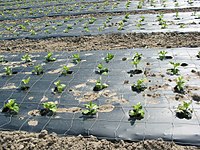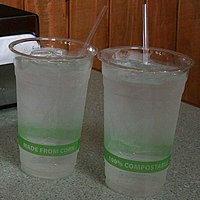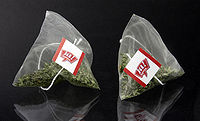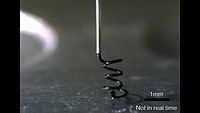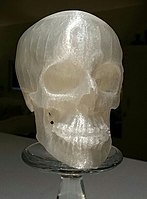聚乳酸
编辑1 合成编辑
应用级(即高分子量)聚乳酸的工业化生产路线不止一种。主要使用两种单体::乳酸和环状二酯丙交酯。聚乳酸最常见的合成路线是丙交酯在溶液、熔融态或悬浊液中与各种金属催化剂(通常为辛酸亚锡)进行开环聚合。与原料(通常是玉米淀粉)相比,金属催化的反应易导致聚乳酸的外消旋化,降低了其立构规整性。[3]
聚乳酸的另一种合成路线是乳酸单体的直接缩合。该过程需要在低于200°C的温度下进行;在该温度以上,生成熵有利的丙交酯单体。该反应在每个缩合(酯化)步骤生成一当量的水。缩合反应是可逆反应,因此需要除水来促进高分子量物质的生成。需要通过抽真空或共沸蒸馏除去水分,从而驱动反应进行缩聚。用这种方法可以获得130 kDa分子量的聚乳酸。小心地从熔体中结晶出粗聚合物,甚至可以获得更高分子量的聚合物。端基的羧酸与羟基浓缩在固体聚合物的无定型区域中,因此它们可以反应并获得128-152 kDa的分子量的聚乳酸。[3]
将左旋乳酸和右旋乳酸的外消旋混合物聚合,可以得到无定形的聚-DL-丙交酯。使用立体定向催化剂可以合成具有结晶度的杂规聚合物。结晶度以及许多重要的性质在很大程度上受所用对映异构体的比例控制,相对而言,催化剂类型对这些性质的影响较小。除了乳酸和丙交酯之外,学术界也采用一种五元环状化合物——乳酸氧-羧基环内酸酐(lac-OCA)来合成聚乳酸。这种化合物比丙交酯更具反应性,因为它的聚合是由每当量乳酸损失一当量二氧化碳来驱动的。水不是副产物。[4]
也有文献报道用类似于聚羟基烷酸酯生物合成方式来合成聚乳酸。[5]
2 物质属性编辑
2.1 化学性质
由于乳酸的手性性质,存在几种不同形式的聚乳酸:左旋聚乳酸(PLLA)是左旋丙交酯聚合的产物。聚乳酸可溶于热苯、四氢呋喃和二恶烷等溶剂。[8]
2.2 物理和机械性能
聚乳酸聚合物既可以是无定形玻璃状聚合物,也可以是半结晶和高结晶聚合物,玻璃化转变温度为60°C,熔点为130-180°C。[9] 耐热聚乳酸能承受110°C的温度。[10]聚乳酸的基本机械性能介于聚苯乙烯和聚酯之间。[11][12] [9] 通过将PLLA(左旋聚乳酸)与PDLA(右旋聚乳酸)物理共混,PLLA的熔融温度可提高40-50°C,热挠曲温度可从约60°C提高至190°C。PDLA和PLLA形成高度规则的立体复合物,结晶度增加。当混合物中PDLA与PLLA的比例在1:1时,热稳定性达到最佳,但是即使PDLA在3-10%的低浓度条件下,热稳定性仍然有很大的改善。在后一种情况下,PDLA起到成核剂的作用,从而增加了结晶速率。PDLA的生物降解比聚乳酸慢,因为PDLA的结晶度更高。聚乳酸的弯曲模量高于聚苯乙烯,具有良好的热封性能。
退火[13][14][15] 、加入成核剂、用纤维或纳米颗粒形成复合材料、[16][17][18] 扩链[19][20]、引入交联结构等多种技术可以提高聚乳酸聚合物的机械性能。聚乳酸可以像大多数热塑性塑料一样加工成纤维(例如,使用传统的熔融纺丝工艺)和薄膜。聚乳酸具有与PETE聚合物相似的机械性能,但连续使用温度上限明显较低。[21] 聚乳酸表面能高,易于印刷,因此广泛应用于3D打印。3D打印聚乳酸的拉伸强度是预先确定的。[22]
另外,左旋聚乳酸与右旋聚乳酸的共聚物(PLDLLA)以PLDLLA/磷酸三钙复合物支架的形式应用于骨工程领域。[23][24]
2.3 溶剂焊接
聚乳酸可以用二氯甲烷进行溶剂焊接。[25]
3 应用编辑
以聚乳酸为打印材料[26][27] 的固体可以被包裹在石膏状的模制材料中,然后在熔炉中烧掉,这样产生的空隙可以被熔融金属填充。这就是所谓的“失聚乳酸法铸造”,它是一种熔模铸造技术。[28]
聚乳酸能够降解成无害的乳酸,可用来制作锚、螺钉、板、针、棒和筛网形状的医疗植入物。[29] 它会在6个月到2年内在体内分解,其降解时间的长短取决于聚乳酸的种类。聚乳酸材料这种逐渐降解的特点使其非常适合用于支撑结构,因为当该区域愈合时,它逐渐将负荷转移到身体(例如骨骼)。文献中清晰地记录了聚乳酸和PLLA植入物的强度特性。[30]
聚乳酸也可用作可分解的包装材料,成型方式可以是浇铸成型、注射成型和纺丝成型。[29]聚乳酸也可用于生产杯子和袋子。在薄膜形式下的聚乳酸加热时会收缩,因此可用于收缩包装领域。它可用于生产散装包装、堆肥袋、食品包装和一次性餐具。以聚乳酸制造的纤维和无纺布也有许多潜在的用途,例如作为室内装潢织物、一次性服装、遮阳篷、女性卫生产品和尿布。由于其生物相容性和生物可降解性,聚乳酸作为药物递送载体的前景也很广阔。
外消旋和常规的PLLA具有很低的玻璃化转变温度,这是其缺点。PDLA和PLLA的立体复合物具有更高的玻璃化转变温度,使其机械强度更佳。这种复合物应用广泛,如梭织衬衫(提高可熨烫性)、微波托盘、热灌装应用,甚至可用于工程塑料领域(在这种情况下,立体复合物与橡胶状聚合物,如丙烯腈-丁二烯-苯乙烯共聚物(ABS)进行混合)。这种混合物还具有良好的形状稳定性和视觉透明度,使其可用于低端包装应用。另一方面,纯聚左旋乳酸(PLLA)是Sculptra的主要成分,Sculptra是一种持久的面部体积增强剂,主要用于防止脸颊脂肪萎缩。最近,生物技术的进步使得D型对映体的商业化生产开发成为了可能。[31]
聚乳酸也用于电子烟草行业。菲利普·莫里斯公司的电子烟iQOS heets的过滤烟嘴就包含聚乳酸成分,它可以在不吸收烟气的前提下减缓烟气的速度,让烟气有时间在吸入之前冷却到更令人愉快的温度。
聚乳酸混纺“生物-柔性”地膜。
可在餐厅使用的可生物降解的聚乳酸杯。
PLA制成的茶包。内封有薄荷茶。
使用聚交酯和碳纳米管的导电混合物3D印刷微线圈。[32]
利用计算机断层扫描的数据打印出的三维人体头盖骨。使用透明聚乳酸。
4 降解编辑
非生物合成聚乳酸的降解是基于3种机制:[33]
- 水解:主链的酯基被裂解,将分子一分为二,从而降低分子量。
- 热降解:这是一种导致多种化合物生成的复杂现象,如较轻的分子、分子量不同的线性和环状低聚物以及聚乳酸。
- 光降解:在低波长和高能量的紫外线辐射下,阳光诱导聚乳酸降解。这是聚乳酸应用在农业栽培、容器包装与薄膜领域中发生降解的主要原因。
水解反应是:
环境温度下聚乳酸降解速度非常慢,与传统塑料相比没有明显优势。在海水温度为25°C时,聚乳酸在一年内没有降解。[34] 聚乳酸被宣传为可生物降解塑料,这其实是一种误解,如果聚乳酸得到更广泛的应用,塑料污染不会得到改善。
将纯聚乳酸泡沫置于DMEM培养基中,补充胎牛血清(FBS,一种模拟体液的溶液)时,会发生选择性水解。在DMEM+FBS中浸泡30天后,PLLA支架的重量减轻了大约20%。[35]
通过使用金属络合物催化剂,不同分子量的聚乳酸样品被降解成乳酸甲酯(一种环保溶剂)。[36]
一些细菌也能降解聚乳酸,如无枝菌属和糖丝菌属。聚乳酸解聚合酶是一种从拟无枝菌中纯化得到的蛋白酶,也能降解聚乳酸。链霉蛋白酶和白色念球菌中提取的最有效的蛋白酶K均可以降解聚乳酸。[37]
5 使用寿命终止编辑
根据美国材料试验标准D6400,来自不同生产商(Total Corbion, NatureWorks)的聚乳酸已被证明可在工业条件下堆肥。工业堆肥的条件是湿度为58°C,处理时间为6个月。[38][39]
聚乳酸结束其使用寿命的常见方式有四种:
- 回收:可以是化学回收,也可以是机械回收。目前,塑料工业协会树脂识别码7(“其他”)适用于聚乳酸。在比利时,Galactic公司启动了第一个化学回收聚乳酸(Loopla)的试点单位。和机械回收不同的是,在化学回收中,废料含有各种污染物,聚乳酸可以通过热解聚或水解回收为单体。纯化后,单体可用于生产全新的聚乳酸,而不损失原始性能(原料到原料的回收)。
- 堆肥:聚乳酸在工业堆肥条件下是可生物降解的,首先发生水解过程,然后在微生物的作用下,最终聚乳酸得以降解。
- 焚烧:聚乳酸可焚烧,无残留物,产生8368 btu/lb的能量。
- 填埋:因为聚乳酸在环境温度下降解非常缓慢,填埋方式不太可取。
参考文献
- [1]
^Ceresana. "Bioplastics - Study: Market, Analysis, Trends - Ceresana". www.ceresana.com. Archived from the original on 4 November 2017. Retrieved 9 May 2018..
- [2]
^Martin, O; Avérous, L (2001). "Poly(lactic acid): plasticization and properties of biodegradable multiphase systems". Polymer. 42 (14): 6209–6219. doi:10.1016/S0032-3861(01)00086-6..
- [3]
^Södergård, Anders; Mikael Stolt (2010). "3. Industrial Production of High Molecular Weight Poly(Lactic Acid)". In Rafael Auras; Loong-Tak Lim; Susan E. M. Selke; Hideto Tsuji. Poly(Lactic Acid): Synthesis, Structures, Properties, Processing, and Applications. pp. 27–41. doi:10.1002/9780470649848.ch3. ISBN 9780470649848..
- [4]
^Kricheldorf, Hans R.; Jonté, J. Michael (1983). "New polymer syntheses". Polymer Bulletin. 9 (6–7). doi:10.1007/BF00262719..
- [5]
^Jung, Yu Kyung; Kim, Tae Yong (2009). "Metabolic Engineering of Escherichia coli for the production of Polylactic Acid and Its Copolymers". Biotechnology and Bioengineering. 105 (1): 161–71. doi:10.1002/bit.22548. PMID 19937727..
- [6]
^Drury, Jim. "Cheaper, greener, route to bioplastic". reuters.com. Archived from the original on 1 December 2017. Retrieved 9 May 2018..
- [7]
^Dusselier, Michiel; Wouwe, Pieter Van; Dewaele, Annelies; Jacobs, Pierre A.; Sels, Bert F. (3 July 2015). "Shape-selective zeolite catalysis for bioplastics production". Science. 349 (6243): 78–80. Bibcode:2015Sci...349...78D. doi:10.1126/science.aaa7169. PMID 26138977. Archived from the original on 24 September 2017. Retrieved 9 May 2018 – via science.sciencemag.org..
- [8]
^Garlotta, Donald (2001). "A Literature Review of Poly(Lactic Acid)". Journal of Polymers and the Environment. 9 (2): 63–84. doi:10.1023/A:1020200822435. Archived from the original on 26 May 2013..
- [9]
^Lunt, James (1998-01-03). "Large-scale production, properties and commercial applications of polylactic acid polymers". Polymer Degradation and Stability. 59 (1–3): 145–152. doi:10.1016/S0141-3910(97)00148-1. ISSN 0141-3910..
- [10]
^Gina L. Fiore; Feng Jing; Victor G. Young Jr.; Christopher J. Cramer; Marc A. Hillmyer (2010). "High Tg Aliphatic Polyesters by the Polymerization of Spirolactide Derivatives". Polymer Chemistry. 1 (6): 870–877. doi:10.1039/C0PY00029A..
- [11]
^Södergård, Anders; Mikael Stolt (February 2002). "Properties of lactic acid based polymers and their correlation with composition". Progress in Polymer Science. 27 (6): 1123–1163. doi:10.1016/S0079-6700(02)00012-6..
- [12]
^Middelton, John C.; Arthur J. Tipton (2000). "Synthetic biodegradable polymers as orthopedic devices". Biomaterial. 21 (23): 2335–2346. doi:10.1016/S0142-9612(00)00101-0..
- [13]
^Nugroho, Pramono; Mitomo, Hiroshi; Yoshii, Fumio; Kume, Tamikazu (2001-05-01). Degradation and Stability "Degradation of poly(l-lactic acid) by γ-irradiation" Check |url= value (help). 72 (2): 337–343. doi:10.1016/S0141-3910(01)00030-1. ISSN 0141-3910..
- [14]
^Urayama, Hiroshi; Kanamori, Takeshi; Fukushima, Kazuki; Kimura, Yoshiharu (2003-09-01). "Controlled crystal nucleation in the melt-crystallization of poly(l-lactide) and poly(l-lactide)/poly(d-lactide) stereocomplex". Polymer. 44 (19): 5635–5641. doi:10.1016/S0032-3861(03)00583-4. ISSN 0032-3861..
- [15]
^Tsuji, H. (1995-01-01). "Properties and morphologies of poly(l-lactide): 1. Annealing condition effects on properties and morphologies of poly(l-lactide)". Polymer. 36 (14): 2709–2716. doi:10.1016/0032-3861(95)93647-5. ISSN 0032-3861..
- [16]
^Urayama, Hiroshi; Ma, Chenghuan; Kimura, Yoshiharu (July 2003). "Mechanical and Thermal Properties of Poly(L-lactide) Incorporating Various Inorganic Fillers with Particle and Whisker Shapes". Macromolecular Materials and Engineering. 288 (7): 562–568. doi:10.1002/mame.200350004. ISSN 1438-7492..
- [17]
^Trimaille, T.; Pichot, C.; Elaïssari, A.; Fessi, H.; Briançon, S.; Delair, T. (2003-11-01). "Poly(d,l-lactic acid) nanoparticle preparation and colloidal characterization". Colloid and Polymer Science. 281 (12): 1184–1190. doi:10.1007/s00396-003-0894-1. ISSN 0303-402X..
- [18]
^Hu, Xiao; Xu, Hong-Sheng; Li, Zhong-Ming (2007-05-04). "Morphology and Properties of Poly(L-Lactide) (PLLA) Filled with Hollow Glass Beads". Macromolecular Materials and Engineering. 292 (5): 646–654. doi:10.1002/mame.200600504. ISSN 1438-7492..
- [19]
^Li, Bo-Hsin; Yang, Ming-Chien (2006). "Improvement of thermal and mechanical properties of poly(L-lactic acid) with 4,4-methylene diphenyl diisocyanate". Polymers for Advanced Technologies. 17 (6): 439–443. doi:10.1002/pat.731. ISSN 1042-7147..
- [20]
^Di, Yingwei; Iannace, Salvatore; Di Maio, Ernesto; Nicolais, Luigi (2005-11-04). "Reactively Modified Poly(lactic acid): Properties and Foam Processing". Macromolecular Materials and Engineering. 290 (11): 1083–1090. doi:10.1002/mame.200500115. ISSN 1438-7492..
- [21]
^"Compare Materials: PLA and PETE". Makeitfrom.com. Archived from the original on 1 May 2011. Retrieved 11 April 2011..
- [22]
^Giordano, R.A.; Wu, B.M.; Borland, S.W.; Cima, L.G.; Sachs, E.M.; Cima, M.J. (1997). "Mechanical properties of dense polylactic acid structures fabricated by three dimensional printing". Journal of Biomaterials Science, Polymer Edition. 8 (1): 63–75. doi:10.1163/156856297x00588..
- [23]
^Lam, C. X. F.; Olkowski, R.; Swieszkowski, W.; Tan, K. C.; Gibson, I.; Hutmacher, D. W. (2008). "Mechanical and in vitro evaluations of composite PLDLLA/TCP scaffolds for bone engineering". Virtual and Physical Prototyping. 3 (4): 193–197. doi:10.1080/17452750802551298..
- [24]
^Bose, S.; Vahabzadeh, S.; Bandyopadhyay, A. (2013). "Bone tissue engineering using 3D printing". Materials Today. 16 (12): 496–504. doi:10.1016/j.mattod.2013.11.017..
- [25]
^Coysh, Adrian (12 April 2013). "Dichloromethane Vapor Treating PLA parts". Thingiverse.com. Archived from the original on 1 December 2017. Retrieved 9 May 2018..
- [26]
^"PLA". Reprap Wiki. 4 April 2011. Archived from the original on 16 July 2011. Retrieved 11 April 2011..
- [27]
^"PLA". MakerBot Industries. Archived from the original on 23 April 2011. Retrieved 11 April 2011..
- [28]
^"Metal Casting with Your 3D Printer | Make:". Make: DIY Projects and Ideas for Makers. Retrieved 2018-11-30..
- [29]
^Rafael Auras; Loong-Tak Lim; Susan E. M. Selke; Hideto Tsuji, eds. (2010). Poly(Lactic Acid): Synthesis, Structures, Properties, Processing, and Applications. doi:10.1002/9780470649848. ISBN 9780470293669..
- [30]
^Nazre, A.; Lin, S. (1994). Harvey, J. Paul; Games, Robert F., eds. Theoretical Strength Comparison of Bioabsorbable (PLLA) Plates and Conventional Stainless Steel and Titanium Plates Used in Internal Fracture Fixation. p. 53. ISBN 978-0-8031-1897-3..
- [31]
^"Bioengineers succeed in producing plastic without the use of fossil fuels". Physorg.com. Archived from the original on 6 June 2011. Retrieved 11 April 2011..
- [32]
^Guo, Shuang-Zhuang; Yang, Xuelu; Heuzey, Marie-Claude; Therriault, Daniel (2015). "3D printing of a multifunctional nanocomposite helical liquid sensor". Nanoscale. 7 (15): 6451–6. Bibcode:2015Nanos...7.6451G. doi:10.1039/C5NR00278H. PMID 25793923..
- [33]
^Castro-Aguirre, E.; Iñiguez-Franco, F.; Samsudin, H.; Fang, X.; Auras, R. (December 2016). "Poly(lactic acid)—Mass production, processing, industrial applications, and end of life". Advanced Drug Delivery Reviews. 107: 333–366. doi:10.1016/j.addr.2016.03.010..
- [34]
^Bagheri, Amir Reza; Laforsch, Christian; Greiner, Andreas; Agarwal, Seema (July 2017). "Fate of So-Called Biodegradable Polymers in Seawater and Freshwater". Global Challenges. 1 (4): 1700048. doi:10.1002/gch2.201700048..
- [35]
^Pavia FC; La Carrubba V; Piccarolo S; Brucato V (August 2008). "Polymeric scaffolds prepared via thermally induced phase separation: tuning of structure and morphology". Journal of Biomedical Materials Research Part A. 86 (2): 459–466. doi:10.1002/jbm.a.31621. PMID 17975822..
- [36]
^Román-Ramírez, Luis A.; Mckeown, Paul; Jones, Matthew D.; Wood, Joseph (2019-01-04). "Poly(lactic acid) Degradation into Methyl Lactate Catalyzed by a Well-Defined Zn(II) Complex". ACS Catalysis. 9 (1): 409–416. doi:10.1021/acscatal.8b04863..
- [37]
^Yutaka Tokiwa; Buenaventurada P. Calabia; Charles U. Ugwu; Seiichi Aiba (September 2009). "Biodegradability of Plastics". International Journal of Molecular Sciences. 10 (9): 3722–3742. doi:10.3390/ijms10093722. PMC 2769161. PMID 19865515..
- [38]
^"Total Corbion EN 13432 certification (ASTM D6400)" (PDF)..
- [39]
^"NatureWorks | Composting". www.natureworksllc.com. Retrieved 2019-05-03..
暂无
